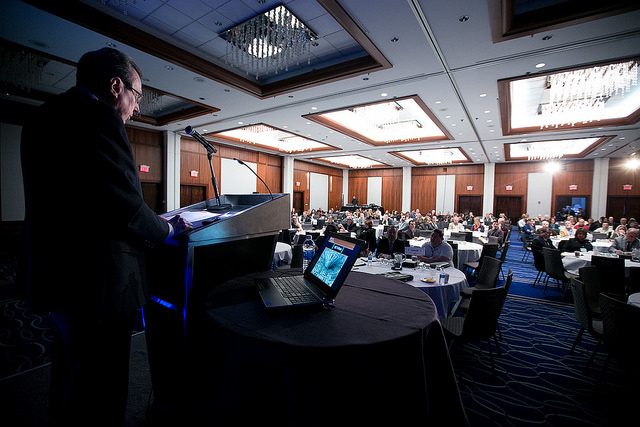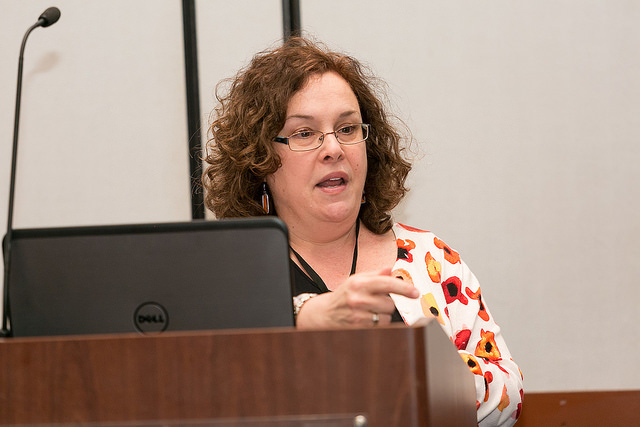On January 26-27, the American Planning Association New Jersey chapter and the Bloustein School presented the 2017 New Jersey Planning Conference. As the only planning school in the state, faculty and staff from the Bloustein School have a major presence during the two-day event. The event has more than tripled in size over the last several years, and both the Bloustein School and the APA-NJ chapter play a major role in helping provide continuing education credits to our many colleagues throughout the state through the panels and sessions offered at the conference. Bloustein School graduate students are also encouraged to attend the many panels for a chance to learn about the most current planning and policy trends in the state as well as network.
This year, the Bloustein School’s undergraduate communications intern Paul Hislip (Class of 2018) attended several of the school-affiliated panels and offered the following summaries.
Building Capacity to Advance Science-Informed Resilience Planning
Though Superstorm Sandy was five years ago, many New Jersey communities are still recovering from the sheer amount of damage the storm caused. Moreover, there is still much work to be done in terms of getting people to prepare proactively for storms, as opposed to waiting until one happens. The old adage is that the Jersey Shore is “stronger than the storm,” but today’s panelists noted that with sea levels on the rise, they should strive to be “smarter than the storm” instead. This is an important paradigm shift to make sooner rather than later.
Led by Jeanne Herb, Associate Director of the Bloustein School’s Environmental Analysis and Communications (EAC) Group, the panelists introduced several website that community leaders now use as planning tools. One such site, she noted, is www.prepareyourcommunitynj.org, whose mantra of “assess, plan, implement” set the tone for the panel. She noted that before these websites existed, community leaders did not consider resilience in their strategic plans. Now there is much more engagement from community leaders to citizens on topics such as resilience. While there are benefits and deficits to doing things like raising homes, the better question to ask is “How much does doing nothing cost?” and, “If no action is taken, how badly will that impact a community?”
Another thing to keep in mind when planning in communities where flooding is a danger is the sea level rise. The sea level is going to keep rising, noted EAC Senior Research Specialist Matt Campo, showing slides long-term sea level statistics. The middle distribution for the sea level increase from now to 2100 is 2.3 to 3.4 feet. That may not seem like much, he said, especially for a date that far in the future but every inch adds up; a nor’easter today could be the high tide of the future.Other statistics show that there is a small chance that the sea level could rise as high as 10 feet. Thus, it is important that community leaders discuss these topics with their communities, as well as discuss things like bringing homes farther inland or raising them.
2017 Economic, Demographic, and Technological Realities
The second day of the conference began with a short address from Bloustein School Dean James W. Hughes on the past and future of New Jersey and planning. Dr. Hughes began by talking about the cyclical state of the economy in the United States and New Jersey, inserting several adages; on the collapse of the tech bubble and the housing bubble, “You don’t know you’re in an economic bubble until it bursts,” while on the expansions and recessions of the economy, “Economic wild parties lead to economic hangovers”.
Dr. Hughes went on to discuss how things have changed for the public world in the past decade. Homeownership has dropped since 2006, and while jobs were on the rise for a few years, they are back down again. He also noted that while the country may have recovered from the recession, New Jersey still has a ways to go in regards to jobs.
Another layer of this interesting situation is the millennial generation and what sort of traits they possess compared to other generations, as well as technological advances of the time like artificial intelligence. Millennials, and where they move to when the time comes for them to leave the nest, could very well influence policy for the future, and AI could prove to be very disruptive to the status quo of the planning world.
So what exactly does all this mean for planners? It is hard to say, he said. We are not at a point yet where we can predict what the next “game changer” will be, and the planning world we may want to come, or that we think is coming, may not necessarily be the one that will come.
Planning the Future of North Jersey’s Transportation and Economy
Martin Robins, director emeritus of the Bloustein School’s Alan M. Voorhees Transportation Center, and Michael Lysicatos, advocate for the North Jersey Rail Coalition (NJRC), held a session on rail services in northern New Jersey, specifically in Passaic, Bergen and Hudson counties. They talked about the traffic congestion that severely affects these counties. Amtrak is handling the Gateway Tunnel Project, which would help to alleviate congestion on the rail system, and through it, other projects can flourish. Several projects have been proposed and put into motion by Amtrak, NJ Transit and the NJRC, with one from NJRC and one from Amtrak being highlighted here.
Michael Lysicatos spoke passionately about the NJRC’s Passaic-Bergen-Hudson Rail Line, a service that would eventually connect municipalities as far as Hawthorne and Paterson with the existing Hudson-Bergen Light Rail. The project has two phases: phase one connects Hawthorne to Hackensack, and phase two connects Hackensack to North Bergen. He made the point that this project is not meant to be in competition with NJ Transit’s Hudson-Bergen Light Rail system and its own northbound expansion; this is meant to help the residents of these towns and to this end, the NJRC and NJ Transit should be cooperating instead of competing.
Martin Robins proceeded to talk about the project that he is overseeing, the Bergen Loop. Dr. Robins previously oversaw NJ Transit’s Access to the Region’s Core (ARC project). The Bergen Loop is a section of track around Secaucus that will help with the system’s resilience in light of Superstorm Sandy, and ultimately increase rail capacity and alleviate congestion from Secaucus to New York City.
Amtrak’s Gateway Tunnel Project is what allows these other projects to be considered. So, what is it? As Robins explained, the project seeks to modernize the infrastructure of rail between Secaucus and New York, including the creation of an additional tunnel and trackage for NJ Transit and Amtrak trains coming in and out of New York City. Extra capacity in and out of NYC would get more people on trains, while simultaneously alleviating the traffic congestion in the Passaic, Bergen and Hudson counties.
If You Can’t Get Thre It Doesn’t Exist: What Mobility Delivers
Transportation is something that is taken for granted, but for those who do not own cars or cannot travel on their own for whatever reason, their ability to go places is greatly limited. The first speaker, Karen Alexander, managing director of NJTIP @ Rutgers, spoke about people’s spheres of mobility. There are three layers to this sphere: walking or biking, public transportation, and private vehicles. Not everyone has access to a private vehicle, and some do not even have access to public transportation. That is where services like the North Jersey Transportation Planning Authority (NJTPA) come in. The NJTPA is a state-funded organization that teaches adults how to use public transportation, thus greatly increasing their mobility. If, say, someone living in Montclair were able to figure out how to make it to Newark Airport, from there he or she could go to many other places. That is a short trip, but being able to make it on one’s own is something that sometimes is taken for granted. The primary demographic of the NJTPA is the elderly, but other demographics like people with disabilities and low-income workers make extensive use of NJTPA’s services. Voters are in support of public transit, which means NJTPA still has a bright future ahead of it.
Ana Magri, Director of NJ Transit’s Local Programs/Minibus Support (LPS) Department, explained the role of her department. The LPS aims to provide senior citizens and the disabled with more mobility by helping to develop a seamless transportation network for the entire state. To this end, they administer millions of dollars in grants to transportation programs statewide, and help to coordinate NJ Transit’s efforts with these local programs, known as community transportation services. Magri also introduced the SCDRTAP, or the Senior Citizen & Disabled Resident Transportation Assistance Program, a NJ Transit service that helps to provide transportation for senior citizens and the disabled for medical, educational, or recreational purposes. She went on to discuss the Job Access and Reverse Commute (JARC) program, a grant program that helps with the development of new or expanding paratransit services. Magri urged transportation planners to reach out to the director of their county’s coordinated transportation system and work alongside them.
The next speaker, Krishna Murthy, director of the EZ Ride shuttle system, discussed the Coordinated Human Services Transportation Plan, which helps to identify the needs of people like low-income workers and senior citizens. He stressed that it is important to have the transportation plan in order for several agencies in order to coordinate, because there are many moving parts in the transportation industry, and having one common document for them all to work with helps to keep things—and people—moving.
The last speaker, Jeffrey Perlman, brought the conversation back to NJTPA. He discussed how the NJTPA is an example of a transportation management associate (TMA). New Jersey is a rarity in that it has TMAs that service the entire state. Not all TMAs provide service, but they help to provide information about the services available. He also noted that TMAs are good to work with in the planning world as they reflect federal and state priorities on a county level.


